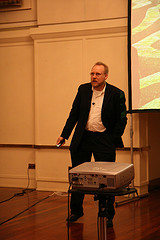The Eurostar and the underground brought Rob, Gino and me to the Glazier’s Hall in time for the opening keynote by Jeff Paton. This was an entertaining presentation about iteration, with old rockers as personas and including bits of music to underline the message.
The talk focused on iteration as a means to embrace change.
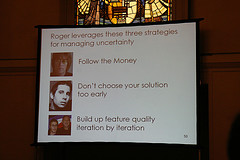 Roger the customer sees each story as just “one more brick in the wall”, purely incremental development. Each iteration delivers a few more working stories. Yes… but what if we discover some new information about these stories? What if the story isn’t really done? Where do we find the time to improve, to iterate? Because we promised Roger to deliver more stories in the next increment, there is no more time to iterate. So, slip the release or make Roger unhappy?
Roger the customer sees each story as just “one more brick in the wall”, purely incremental development. Each iteration delivers a few more working stories. Yes… but what if we discover some new information about these stories? What if the story isn’t really done? Where do we find the time to improve, to iterate? Because we promised Roger to deliver more stories in the next increment, there is no more time to iterate. So, slip the release or make Roger unhappy?
There is another way.
Enter John, Paul, Pete and Roger. Each offers us a handy strategy in a song. John tells us to “Follow the money”: we’re in the business of producing business value. So, ensure you know what value each and every story brings.
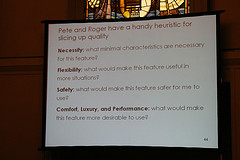 Paul has lots of ways to leave his lover, and lots of ways to do everything that must be done on the project. He tells us to choose as late as possible, to leave our options open as long as possible (remember: Lean and real options).
Paul has lots of ways to leave his lover, and lots of ways to do everything that must be done on the project. He tells us to choose as late as possible, to leave our options open as long as possible (remember: Lean and real options).
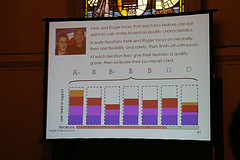 Pete and Roger have a plan and a handy heuristic to slice up quality (see picture above, click to enlarge): they can implement any story up to several levels of quality. First they build based on necessity; then flexibility; then safety; then comfort, luxury and performance. Like in the Dimensional Planning method: build a basic version of the story in the first iteration, improve it in the next iteration. Plan to iterate!
Pete and Roger have a plan and a handy heuristic to slice up quality (see picture above, click to enlarge): they can implement any story up to several levels of quality. First they build based on necessity; then flexibility; then safety; then comfort, luxury and performance. Like in the Dimensional Planning method: build a basic version of the story in the first iteration, improve it in the next iteration. Plan to iterate!
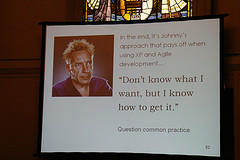 Pete and Roger have a good thing going: they always have a working system; their customer is often satisfied with a story implementation that does not have all the niceties; they have time left to ensure that the crucial stories are completed with full luxury; they have enough time to iterate, to embrace change. Those are the stories that delight the customers. Because in the end we, like Johnny Rotten , “Don’t know what we want, but we know how to get it!”.
Pete and Roger have a good thing going: they always have a working system; their customer is often satisfied with a story implementation that does not have all the niceties; they have time left to ensure that the crucial stories are completed with full luxury; they have enough time to iterate, to embrace change. Those are the stories that delight the customers. Because in the end we, like Johnny Rotten , “Don’t know what we want, but we know how to get it!”.
Cue Sex Pistols!
This was an excellent keynote: questioning common practice, clear slides, a sustained methaphor (old rockers as personas by a User Centered Design specialist), sparing but effective use of music (at least for those in the audience to recognize the old geezers…) and enough humour. This presentation was recorded. I’m looking forward to seeing the presentation again.
Understanding the Organisational Context of Agility
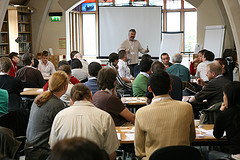 Michael Feathers’ session was packed full. The presenters in the Gary Weston room in Southwark Cathedral (XP Days has expanded to fill two more rooms in the cathedral) always seemed surprised that so many people came to their “Peopleware” session. In this session, we explored the important aspects of organisations that impact the introduction and survival of agile. Afterward, each group explored one of these aspects in depth. In my group, we explored the effects of an organisation that is mainly organized around projects vs one that is organized around product development.
Michael Feathers’ session was packed full. The presenters in the Gary Weston room in Southwark Cathedral (XP Days has expanded to fill two more rooms in the cathedral) always seemed surprised that so many people came to their “Peopleware” session. In this session, we explored the important aspects of organisations that impact the introduction and survival of agile. Afterward, each group explored one of these aspects in depth. In my group, we explored the effects of an organisation that is mainly organized around projects vs one that is organized around product development.
Each model has its advantages and disadvantages. Maybe a combination of both can bring us the best of both worlds. Or the worst of both worlds.
I took the notes for our group. These will be published on a wiki. I’ll let you know when the results are available.
And then it was time for lunch and 3 more sessions in the afternoon.
The social nature of agile teams
Elizabeth Whitworth presented the results of her research into collaboration and communication on agile teams. She interviewed participants in agile teams about motivation, excitement, “team chemistry” and positive “team climate”; what makes a great team great? Elizabeth’s presentation could have been a bit more “Zen“: less info (we can find that by reading the thesis), more passion, more fun, more about what the people in those teams said and felt. An interesting presentation, we need to know more about great teams, so that we can create more great teams.
Exceptional ideas: How to get your message through
Lasse Koskela presented a few heuristics for messages that ‘stick’: strong messages are D(eep), I(ndulgent), C(omplete), E(motional) and E(legant) and they are S(imple), U(nexpected), C(oncrete), C(redible), E(motional) and have a S(tory). Okay, the DICEE acronym isn’t the most catchy in the world 🙂
After the explanation, we got to create an exceptional message. We had two rounds. In the first round, each group created a message. In the second round, one member of each team went to another team to hear the message. The team then used that feedback to improve their message. Again, I experienced the power of positive feedback: the second version was a lot better than the first. This was a too short, but fun session.
The yellow brick road
This session, hosted by Portia Tung and Duncan Pierce, was one of the highlights of the conference. I’ll post an entry about this session tomorrow.
Thanks to Lasse Koskela for the use of his pictures.
